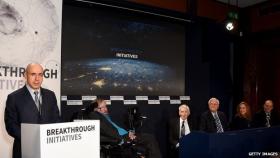
Пресс-конференция в Нью-Йорке 12 апреля 2016 года, на которой Юрий Мильнер и Стивен Хокинг представили проект StarShot
In 2015, Russian billionaire Yuri Milner founded Breakthrough Initiatives with the intention of bolstering the search for extra-terrestrial life. Since that time, the non-profit organization – which is backed by Stephen Hawking and Mark Zuckerberg – has announced a number of advanced projects. The most ambitious of these is arguably Project Starshot, an interstellar mission that would make the journey to the nearest star in just 20 years.
This concept involves an ultra-light nanocraft that would rely on a laser-driven sail to achieve speeds of up to 20% the speed of light. Naturally, for such a mission to be successful, a number of engineering challenges have to be tackled first. And according to a recent study by a team of international researchers, two of the most important issues are the shape of the sail itself, and the type of laser involved.
The researchers include Elena Popova of the Skobeltsyn Institute of Nuclear Physics in Moscow; Messoud Efendiev of the Institute of Computational Biology (ICB) at the German Research Center for Environmental Health (GmbH); and Ildar Gabitov of the Skoltech Center for Photonics and Quantum Materials in Moscow. Combining their expertise, they conducted a study that examined various stability models for this proposed mission.
As they indicate in their study, titled “On the Stability of a Space Vehicle Riding on an Intense Laser Beam“, the team ran stability simulations 0n the concept, taking into account the nature of the wafer-sized craft (aka. StarChip), the sail (aka. Lightsail) and the nature of the laser itself. For the sake of these simulations, they also factored in a number of assumptions about Starshot’s design.
These included the notion that the StarChip would be a rigid body (i.e. made up of solid material), that the circular sail would either be flat, spherical or conical (i.e. concave in shape), and that the surface of the sail would reflect the laser light. Beyond this, they played with multiple variations on the design, and came up with some rather telling results.
As Dr. Elena Popova, the lead author on the paper, told Universe Today via email:
“We considered different shapes of sail: a) spherical (coincides with parabolic for small sizes) as most appropriate for final configuration of nanocraft en route; b) conical; c) flat (simplest) (will be seen to be unstable so that even spinning of craft does not help).”
What they found was that the simplest, stable configuration would involve a sail that was spherical in shape. It would also require that the StarChip be tethered at a sufficient distance from the sail, one which would be longer than the curvature radius of the sail itself.
“For the sail with almost flat cone shape we obtained similar stability condition,” said Popova. “The nanocraft with flat sail is unstable in every case. It simply corresponds to the case of infinite radius of curvature of the sale. Hence, there is no way to extend center of mass beyond it.”
As for the laser, they considered several how the two main types would effect stability. This included uniform lasers that have a sharp boundary and “Gaussian” beams, which are characterized by high-intensity in the middle that declines rapidly towards the edges. As Dr. Popova stated, they determined that in order to ensure stability – and that the craft wouldn’t be lost to space – a uniform laser was the way to go.
“The nanocraft driven by intense laser beam pressure acting on its Lightsail is sensitive to the torques and lateral forces reacting on the surface of the sail. These forces influence the orientation and lateral displacement of the spacecraft, thus affecting its dynamics. If unstable the nanocraft might even be expelled from the area of laser beam. The most dangerous perturbations in the position of nanocraft inside the beam and its orientation relative to the beam axis are those with direct coupling between rotation and displacement (“spin-orbit coupling”).”
See more: http://www.universetoday.com/131673/whats-stable-shape-interstellar-ligh...
